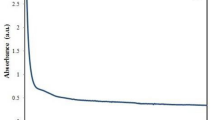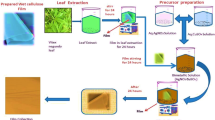Abstract
The rapid expansion of drug-resistant pathogens has created huge global impact and development of novel antimicrobial leads is one of the top priority studies in the current scenario. The present study aims to develop bio-hybridized nanocellulose films which comprise of phytogenic silver nanobactericides. The nanobactericides were synthesized by treating 1 mM silver nitrate with aqueous extract of Chamerion angustifolium which reduced the metal salt to produce polydispersed nanobactericides which were tested against the members of ESKAPE drug-resistant communities. The synthesized silver nanobactericides were subjected to characterization with UV–visible spectra which displayed maximum absorbance at 408 nm. The bio-molecular interaction of phyto-constituents to mediate synthesis and stabilization of nanobactericides was studied with Fourier-transform infrared spectroscopy (FTIR) which depicted functional groups associated with nanobactericides. The crystalline nature was studied with X-ray diffraction (XRD) which showed Bragg’s intensities at 2θ angle which denoted (111), (200), (220), and (311) planes. The morphological characteristics of silver nanobactericides were defined with transmission electron Microscopy (TEM) image which displayed polydispersity of silver nanobactericides with size ranging from 2 to 40 nm. The synthesized nanobactericides showed a significant activity against MRSA strain with 21 mm zone of inhibition. The minimal inhibitory concentration of silver nanobactericides to inhibit the growth of test pathogens was also determined which ranged between 0.625 and 1.25 μg/ml. The silver nanobactericides were bio-hybridized onto nanocellulose films produced by Komagataeibacter xylinus B-12068 culture strain. The films were dried to determine the mechanical properties which showed increased in Young’s modulus and tensile strength in comparison with control bacterial cellulose films. Overall, the results obtained in the present investigation are promising enough to report bactericidal activity of bio-hybridized nanobactericidal films against ESKAPE. These communities are reported to cause severe threats to all forms of lives irrespective to their habitats which can lead to huge economical crisis.







Similar content being viewed by others
References
Awwad AM, Salem NM, Abdeen AO (2013) Green synthesis of silver nanoparticles using carob leaf extract and its antibacterial activity. Int J Indus Chem 4:29
Azar ARJ, Mohebbi S (2013) One-pot greener synthesis of silver nanoparticles using tangerine peel extract: large-scale production. Micro Nano Lett 8:813–815
Baker S, Harini B, Rakshith D, Satish S (2013) Marine microbes: invisible nanofactories. J Pharm Res 6:383–388
Barua AG, Hazarika S, Hussain M, Misra AK (2008) Spectroscopic investigation of the cashew nut kernel (Anacardium occidentale). Open Food Sci J 2:85–88
Chandrasekaran A, Ravisankar R, Rajalakshmi A, Eswaran P, Prem Anand D (2013) FT-IR spectroscopy investigation of soils from Yelagiri Hills, Tamil Nadu, India. Sci Acta Xaveriana 4:29–40
Du Y, Huang Z, Wu S, Xiong K, Zhang X, Zheng B, Nadimicherla R, Fu R, Wu D (2018) Preparation of versatile yolk-shell nanoparticles with a precious metal yolk and a microporous polymer shell for high-performance catalysts and antibacterial agents. Polymer. https://doi.org/10.1016/j.polymer.2017.12.069
Faria-Tischer PCS, Costa CAR, Tozetti I, Dallantonia LH, Vidotti M (2016) Structure and effects of gold nanoparticles in bacterial cellulose–polyaniline conductive membranes. RSC Adv 6:9571–9580
Founou LL, Founou RC, Essack SY (2016) Antibiotic resistance in the food chain: a developing country-perspective. Fron Microbiol 7. https://doi.org/10.3389/fmicb.2016.01881
Gao J, Maruyama A (2012) Biohybrid Materials. Adv Biochem Engin. Biotechnol 126:285–296
Gupta PD, Birdi TJ (2017) Development of botanicals to combat antibiotic resistance. J Ayurveda Integr Med 28:1–10
Heli B, Morales-Narváez E, Golmohammadi H, Ajji A, Merkoçi A (2016) Modulation of population density and size of silver nanoparticles embedded in bacterial cellulose via ammonia exposure: visual detection of volatile compounds in a piece of plasmonic nanopaper. Nanoscal 8:7984–7991
Hu S, Hsieh YL (2015) Synthesis of surface bound silver nanoparticles on cellulose fibers using lignin as multi-functional agent. Carbohydr Polym 131:134–141
Jeevan P, Ramya K, Rena AD (2012) Extracellular biosynthesis of silver nanoparticles by culture supernatant of Pseudomonas aeruginosa. Ind J Biotechol 11:72–76
Kanagathara N, Shenbagarajan P, Esther Jeyanthi C, Thirunavukkarasu M (2011) Fourier transform infrared spectroscopic investigation on Nifidipine. Int J Phar Bio sci 1:1–5
Kaniappan K, Latha S (2011) Certain investigation on the formulation and characterization of PS/PMMA blends. Int J Chemtech Res 3:708–717
Kavitha KS, Baker S, Rakshith D, Kavitha HU, Yashwantha Rao HC, Harini BP, Satish S (2013) Plants as green source towards synthesis of nanoparticles. Int Res J Biol Sci 2:66–76
Khan F, Tanaka M, Ahmad SR (2015) Fabrication of polymeric biomaterials: a strategy for tissue engineering and medical devices. J Mater Chem B 3:8224–8249
Kim TW, Joung Y, Han JH, Jung W, Kim SB (2015) Antibiotic resistance among aquatic bacteria in natural freshwater environments of Korea. J Water Heal 13:1085–1097
Kota S, Dumpala P, Anantha RK, Verma MK, Kandepu S (2017) Evaluation of therapeutic potential of the silver/silver chloride nanoparticles synthesized with the aqueous leaf extract of Rumex acetosa. Sci Rep 7:11566
Liyaskina E, Revin V, Paramonova E, Nazarkina M, Pestov N, Revina N, Kolesnikova S (2017) Nanomaterials from bacterial cellulose for antimicrobial wound dressing. J Phys Conf Ser 784:012034. https://doi.org/10.1088/1742-6596/784/1/012034
Ma Y, Li X, Yang Z, Xu S, Zhang W, Su Y, Hu N, Lu W, Feng J, Zhang Y (2016) Morphology control and photocatalysis enhancement by in situ hybridization of cuprous oxide with nitrogen-doped carbon quantum dots. Langmuir 32:9418–9427
Mahmudin L, Suharyadi E, Utomo ABS, Abraha K (2016) Influence of stabilizing agent and synthesis temperature on the optical properties of silver nanoparticles as active materials in surface plasmon resonance (SPR). Biosens. https://doi.org/10.1063/1.4945495
Mai W, Zuo Y, Li C, Wu J, Leng K, Zhang X, Liu R, Fu R, Wu D (2017) Functional nanonetwork-structured polymers with inbuilt poly(acrylic acid) linings for enhanced adsorption. Polym Chem 8:4771–4775
Martin SL, Husband BC (2013) Adaptation of diploid and tetraploid Chamerion Angustifoliumto elevation but not local environment. Evol 67:1780–1791
Mikhlin YL, Vishnyakova EA, Romanchenko AS, Saikova SV, Likhatski MN, Larichev YV, Tuzikov FV, Zaikovskii VI, Zharkov SM (2014) Oxidation of Ag nanoparticles in aqueous media: effect of particle size and capping. Appl Surf Sci 297:75–83
Moniri M, Moghaddam AB, Azizi S, Rahim RA, Ariff AB, Saad WZ, Navaderi M, Mohamad R (2017) Production and status of bacterial cellulose in biomedical engineering. Nanomater 7:257
Owens GJ, Rajendra KS, Farzad F, Mustafa A (2016) Sol–gel based materials for biomedical applications. Progr Mater Sci 77:1–79
Pinno BD, Landhäusser SM, Chow PS, Quideau SA, Mackenzie MD (2014) Nutrient uptake and growth of fireweed (Chamerion angustifolium) on reclamation soils. Can J For Res 44:1–7
Qian Y, Yu H, He D, Yang H, Wang W, Wan X, Wang L (2013) Biosynthesis of silver nanoparticles by the endophytic fungus Epicoccum nigrum and their activity against pathogenic fungi. Bioprocess Biosyst Eng 36:1613–1619
Rather IA, Kim BC, Bajpa VK, Park YH (2017) Self-medication and antibiotic resistance: crisis, current challenges, and prevention. Saudi J Biol Sci. 24:808–812
Rogers R (2014) Fireweed—a treasured medicine of the boreal forest. Discov Phytomed 1:10
Santajit S, Indrawattana N (2016) Mechanisms of antimicrobial resistance in ESKAPE pathogens. Biomed Res Int 2016:1–8
Sarker SD, Nahar L, Kumarasamy Y (2007) Microtitre plate-based antibacterial assay incorporating resazurin as an indicator of cell growth, and its application in the in vitro antibacterial screening of phytochemicals. Methods 42:321–324
Shao W, Wang S, Wu J, Huang M, Liu H, Min H (2016) Synthesis and antimicrobial activity of copper nanoparticle loaded regenerated bacterial cellulose membranes. RSC Adv 6:65879–65884
Shidlovskiy IP, Shumilova AA, Shishatskaya EI (2017) Preparation and characterization of bacterial cellulose composites with silver nanoparticles. J Sib Fed Univ Biol 10:255–264
Singer AC, Shaw H, Rhodes V, Hart A (2016) Review of antimicrobial resistance in the environment and its relevance to environmental regulators. Fron Microbiol 7. https://doi.org/10.3389/fmicb.2016.01728
Sumi MB, Devadiga AK (2016) Solar photocatalytically active, engineered silver nanoparticle synthesis using aqueous extract of mesocarp of Cocos nucifera (Red Spicata Dwarf). J Exp Nanosci 12:14–32
Syed B, Prasad MN, Satish S (2016) Synthesis and characterization of silver nanobactericides produced by Aneurinibacillus migulanus 141, a novel endophyte inhabiting Mimosa pudica L. Arab J Chem. https://doi.org/10.1016/j.arabjc.2016.01.005
Syed B, Bisht N, Bhat PS, Nikhil RK, Nikhil K, Prasad A, Dhananjaya B, Satish S, Prasad H, Prasad NM (2017a) Phytogenic synthesis of nanoparticles from Rhizophora mangle and their bactericidal potential with DNA damage activity. Nano Struct Nano Obj 10:112–115
Syed B, Nagendra PMN, Kumar MK, Dhananjaya B, Satish S (2017b) Endo-symbiont mediated synthesis of gold nanobactericides and their activity against human pathogenic bacteria. Environ Toxicol Pharm. 52:143–149
Teh CH, Nazni WA, Nurulhusna AH, Norazah A, Lee HL (2017) Determination of antibacterial activity and minimum inhibitory concentration of larval extract of fly via resazurin-based turbidometric assay. BMC Microbiol 17:36
Todica M, Stefan R, Pop C, Olar L (2015) IR and raman investigation of some poly(acrylic) acid gels in aqueous and neutralized state. Acta Phys Polon A. 128:128–135
Tsai TT, Huang TH, Chang CJ, Ho NYJ, Tseng YT, Chen CF (2017). Antibacterial cellulose paper made with silver-coated gold nanoparticles. Sci Rep 7. https://doi.org/10.1038/s41598-017-03357
Vergara D, Bellomo C, Zhang X, Vergaro A, Lorusso V, Rinaldi YM, Lvov S, Leporatti S, Maffaia M (2012) Lapatinib/Paclitaxel polyelectrolyte nanocapsules for overcoming multidrug resistance in ovarian cancer. Nanotechnol Biol Med 8:891–899
Viana RB, da Silva ABF, Pimentel AS (2012) Infrared spectroscopy of anionic, cationic, and zwitterionic surfactants. Adv Phys Chem 2012. https://doi.org/10.1155/2012/903272
Volova TG, Shumilova AA, Shidlovskiy IP, Nikolaeva ED, Sukovatiy AG, Vasiliev AD, Shishatskaya EI (2018) Antibacterial properties of films of cellulose composites with silver nanoparticles and antibiotics. Polym Test. 65:54–68
WHO (2017) publishes list of bacteria for which new antibiotics are urgently needed. World Health Organization. http://www.who.int/mediacentre/news/releases/2017/bacteria-antibiotics-needed/en/. Accessed 1 June 2018
WHO (2017) Antimicrobial resistance. http://www.who.int/mediacentre/factsheets/fs194/en/. Accessed 1 June 2018
Witte F, Bartsch I, Willbold E (2012) Designing the biocompatibility of biohybrids. Adv Biochem Eng Biotechnol. 126:285–296
Yang G, Xie J, Hong F, Cao Z, Yang X (2012) Antimicrobial activity of silver nanoparticle impregnated bacterial cellulose membrane: effect of fermentation carbon sources of bacterial cellulose. Carbohyd Polym 87:839–845
Yuanyuan Y, Jin P, Zhang X et al (2017) New Epigallocatechin Gallate (EGCG) nanocomplexes co-assembled with 3-Mercapto-1-Hexanol and β-Lactoglobulin for improvement of antitumor activity. J Biomed Nanotechnol 13:805–814
Zhang XF, Liu ZG, Shen W, Gurunathan S (2016) Silver nanoparticles: synthesis, characterization, properties, applications, and therapeutic approaches. Int J Mol Sci 17:1534
Acknowledgements
Authors are thankful for Ministry of Education and Science of the Russian Federation for providing funding under the scheme of 5-100: Russian Academic Excellence Project. Authors are grateful for facilities provided by Siberian Federal University to carry out the present study.
Author information
Authors and Affiliations
Corresponding author
Ethics declarations
Conflict of interest
All authors state that they do not have any conflict of interest.
Additional information
Publisher’s Note
Springer Nature remains neutral with regard to jurisdictional claims in published maps and institutional affiliations.
Electronic supplementary material
Below is the link to the electronic supplementary material.
Rights and permissions
About this article
Cite this article
Baker, S., Volova, T., Prudnikova, S.V. et al. Bio-hybridization of nanobactericides with cellulose films for effective treatment against members of ESKAPE multi-drug-resistant pathogens. Appl Nanosci 8, 1101–1110 (2018). https://doi.org/10.1007/s13204-018-0717-9
Received:
Accepted:
Published:
Issue Date:
DOI: https://doi.org/10.1007/s13204-018-0717-9




